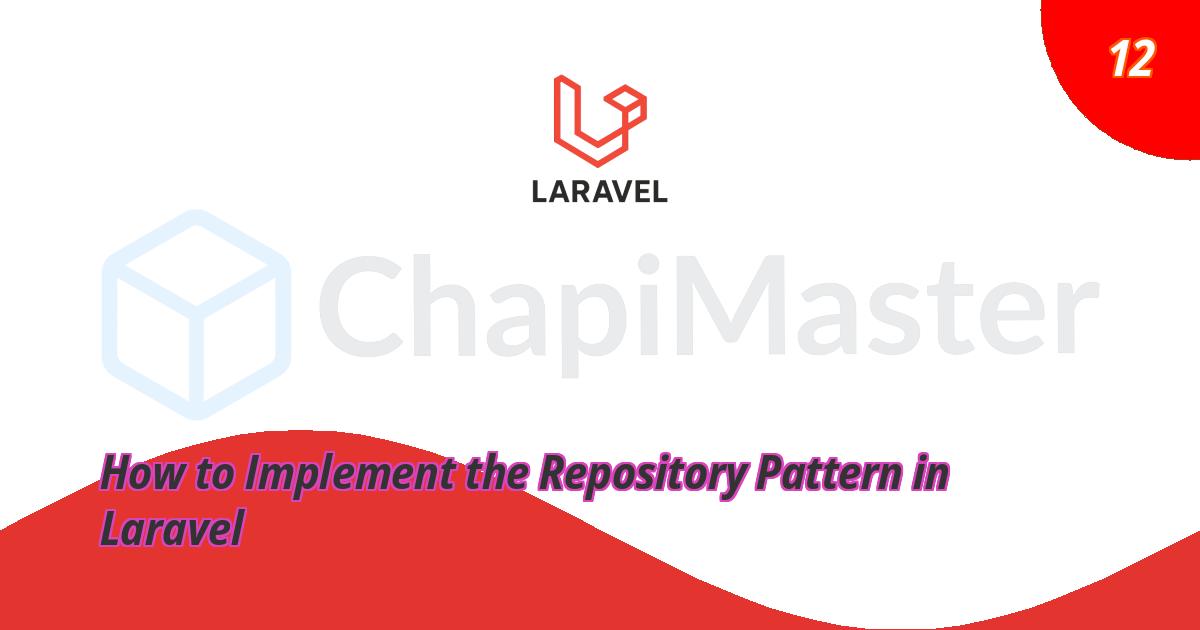Introduction
When building large Laravel applications, your controllers and models can easily become bloated — full of query logic, validation, and data handling. This makes your code harder to maintain and test.
The Repository Pattern helps you solve this by separating your data access logic from your business logic. It acts as an abstraction layer between your controllers (or services) and your models, allowing you to write cleaner, testable, and scalable code.
Why Use the Repository Pattern?
The Repository Pattern helps structure your Laravel codebase more cleanly. Instead of directly calling Eloquent methods inside controllers, you delegate all database interactions to repository classes.
✅ Keeps controllers lightweight and focused
✅ Makes switching data sources easier (e.g., from MySQL to an API)
✅ Improves testability with mocked repositories
✅ Centralizes query logic for better maintainability
When to Use It
Use the Repository Pattern when your app starts growing — especially if:
Multiple parts of the app need similar data queries.
You plan to switch or extend data sources (e.g., APIs, microservices).
You’re building modular, domain-driven, or service-based applications.
⚠️ Note: The Repository Pattern is not necessary for very small apps. It shines when your codebase or team grows.
Implementing the Repository Pattern in Laravel
Let’s walk through a step-by-step example using a Vehicle model.
Step 1: Create a Repository Interface
We’ll define an interface that declares methods for interacting with the data layer.
<?php
namespace App\Repositories;
interface VehicleRepositoryInterface
{
public function all();
public function find(int $id);
public function create(array $data);
public function update(int $id, array $data);
public function delete(int $id);
}
Step 2: Implement the Repository
Next, create a class that implements this interface and interacts with the Eloquent model.
<?php
namespace App\Repositories;
use App\Models\Vehicle;
class VehicleRepository implements VehicleRepositoryInterface
{
public function all()
{
return Vehicle::latest()->get();
}
public function find(int $id)
{
return Vehicle::findOrFail($id);
}
public function create(array $data)
{
return Vehicle::create($data);
}
public function update(int $id, array $data)
{
$vehicle = Vehicle::findOrFail($id);
$vehicle->update($data);
return $vehicle;
}
public function delete(int $id)
{
return Vehicle::destroy($id);
}
}
This class now acts as a single source of truth for all Vehicle data operations.
Step 3: Bind Interface to Implementation
Tell Laravel which implementation to use when the interface is requested. Add this binding in AppServiceProvider:
<?php
namespace App\Providers;
use Illuminate\Support\ServiceProvider;
use App\Repositories\VehicleRepositoryInterface;
use App\Repositories\VehicleRepository;
class AppServiceProvider extends ServiceProvider
{
public function register(): void
{
$this->app->bind(VehicleRepositoryInterface::class, VehicleRepository::class);
}
}
Step 4: Use Repository in Controller
Now inject the repository into your controller instead of using the model directly.
<?php
namespace App\Http\Controllers;
use App\Repositories\VehicleRepositoryInterface;
use Illuminate\Http\Request;
class VehicleController extends Controller
{
protected VehicleRepositoryInterface $vehicles;
public function __construct(VehicleRepositoryInterface $vehicles)
{
$this->vehicles = $vehicles;
}
public function index()
{
return response()->json($this->vehicles->all());
}
public function store(Request $request)
{
$vehicle = $this->vehicles->create($request->all());
return response()->json($vehicle, 201);
}
public function show($id)
{
return response()->json($this->vehicles->find($id));
}
public function update(Request $request, $id)
{
return response()->json($this->vehicles->update($id, $request->all()));
}
public function destroy($id)
{
$this->vehicles->delete($id);
return response()->json(['message' => 'Vehicle deleted']);
}
}
Result
Your controller is now clean, focused, and independent from your database structure. You can easily switch to a different data source or mock your repository during testing.
 Clean and modular code structure using Repository Pattern
Clean and modular code structure using Repository Pattern
Advantages of Repository Pattern in Laravel
✅ Clean separation between business and data layers
✅ Easier to unit test (mock repositories instead of hitting database)
✅ Centralized data access logic
✅ Easier future upgrades and refactoring
⚠️ Pro Tip: Combine the Repository Pattern with
DTOs and Service Layers for a truly enterprise-grade Laravel architecture.
Conclusion
The Repository Pattern is one of the most effective ways to keep your Laravel application’s architecture clean and scalable. It removes repetitive query logic from controllers, promotes consistency, and prepares your codebase for long-term growth.
If you’re working on a growing Laravel project, start implementing repositories early — your future self (and your team) will thank you.



